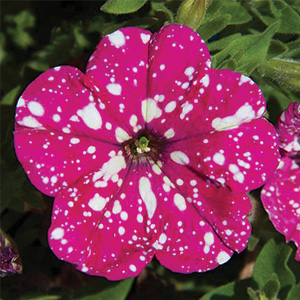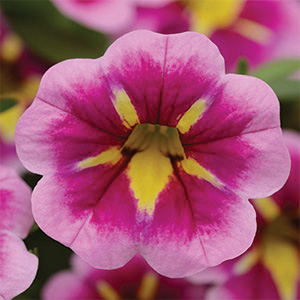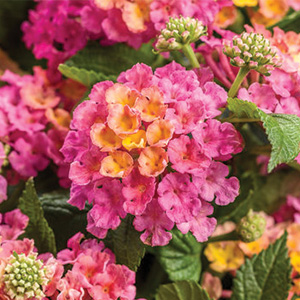
Top New Annuals 2018
By Rob Sproule
Pink Sky Petunia
Can-Can Bumbelbee Pink
Lantana Luscious Royale Cosmo
“In joy or sadness, flowers are our constant friends.”
– Kozuko Okakura
Petunia “Sky Pink”:

If Han Solo were here, he would say this was the strangest petunia in the galaxy. The “Sky” series took the garden world by storm in 2017, and the line continues to grow. This year, the cosmic mysticism of “Night Sky Blue” is joined by a free-spirited pink.
Versatile and bright, the pink is a fair-sized plant at 1′ high with a 2′ spread. It will perform best in a container or hanging basket, where it can flow freely over the sides.
I recommend planting this annual on its own. Each flower is as unique as a fingerprint, so you’ll get a more remarkable show if you give it enough space to bloom. It’s also hard to look away from once you see it, so anything planted with it is bound to suffer from extreme neglect (unless it’s an accent plant like a tall, magenta grass).
“Sky Pinks” are heavy feeders, so give them lots of fertilizer. Add a slow release mix when you plant (if the pellets are not already on the soil), and feed weekly with a high middle number of all-purpose.
Like all petunias, “Sky Pinks” thrive in dry, prairie air and need to be protected from gusty winds. A Southern exposure with some shelter from prevailing winds is ideal.
“Can-Can Bumblebee” Calibrachoa:

As the name implies, “Can-Can Bumblebees” are a party, and the Calibrachoa variety is amazing, going from bi-colour to tri-colour.
Calibrachoas have always held up better in wind than petunias, regardless of their smaller size, and the “Can-Can” is bred specifically to hold up to harsh conditions. If you have a windy spot where petunias get shredded, this might be your answer.
The “Can-Can” has a star, an eye, and it’s a tricolour! It blends well with any other sun-loving, aggressive annual, however, avoid pairing with older 6-pack annuals, or you may find them eaten. A show-off with stamina, it forms a shapely bell of colour that spills over the sides and just keeps blooming.
You won’t need to deadhead your “Can-Can”, and I recommend using it in containers and hanging baskets, rather than a ground planting, as ground soil tends to be too cool for its tropical roots. Pair it with anything pink or yellow for harmonious themes, or purple/ultraviolet for vivid contrast. Mix up the shapes with grasses for even more eye candy.
Feed weekly with an all-purpose fertilizer. “Can-Cans” like more iron than the average bloomer, so aim for a higher last number (20-20-20 is ideal).
Dig in with Alberta’s Best Gardening Blog for more gardening trends and tips!
Lantana “Luscious Royale Cosmo”:

Weather often decides how an annual performs. If our summer is cool and wet, a Lantana will disappoint. However, if it’s hot and dry, you won’t be able to get enough of it’s fiery colours and zesty, Mediterranean vibe.
We all have a spot that’s too hot too handle. It’s usually that Western-facing spot on the desk, right under the reflective siding, where petunias and marigolds scorch. A Lantana will love it.
Proven Winners releases some of the world’s best annuals. Their company ethos is to focus on summer garden performance over how it looks on the garden centre shelf. A “Luscious” Lantana probably won’t look like much in May, but add some faith and heat and it will wow you later.
Pair your Lantana with other heat-lovers, like portulaca and even succulents. It will definitely prefer container life, as the chilly ground soil will stunt their growth. Look for dark pots that absorb sunlight and cook the roots for best results.
As far as raw flower power, you can’t beat a Lantana. The vivid, warm colours will make sitting on the patio feel like lounging at a Greek taverna, overlooking the Mediterranean. Neglect them all you want, all they need is heat, well-draining soil, and a shot of fertilizer every now and then.















